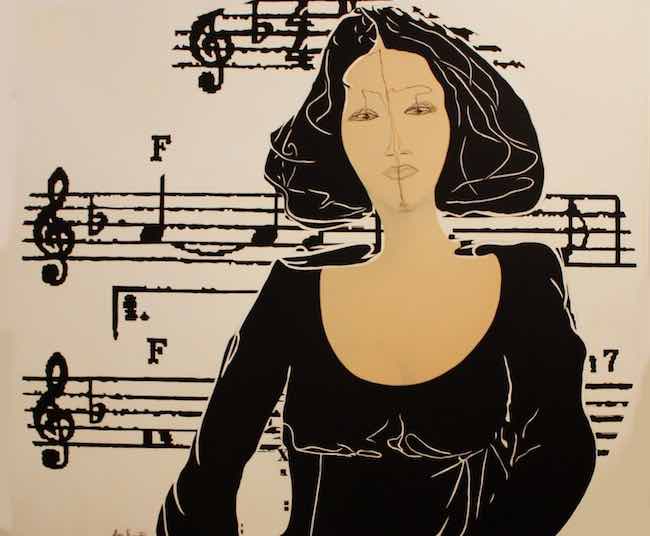L’artista contemporaneo si pone spesso come attento osservatore non solo della realtà che circonda l’esistenza ma anche delle varie sfaccettate personalità di chi incrocia il suo cammino, inducendolo a tendere verso un’interpretazione di soggettività differenti che vanno a comporre il puzzle di ciò che contraddistingue la vita moderna. Altri invece sono alla ricerca di un senso più profondo, si spingono dentro le pieghe dell’irrazionalità per scoprire i significati nascosti che si insinuano oltre il visibile. E poi ci sono quelli che mescolano i due differenti approcci per dar vita a una propria personale cifra stilistica che li identifica e li caratterizza. L’artista di cui vi racconterò oggi appartiene a quest’ultima categoria di creativi.
Nel momento in cui si creò quella frattura tra regole espressive accademiche e l’esigenza di dare libero sfogo a un’interiorità troppo spesso delimitata dagli schemi esecutivi dell’arte tradizionale, emerse il desiderio di trovare un modo di lasciar fluire, o sarebbe meglio dire prevalere, le sensazioni e le emozioni che non avevano mai fatto parte di un’opera, se non in alcuni rari casi, e fu pertanto necessario trovare un nuovo stile pittorico e scultoreo che permettesse ai creativi di mettere in secondo piano tutti i canoni precedenti. Fu quello il momento in cui in Francia nacquero le linee guida dei Fauves che trovarono la loro naturale evoluzione nell’Espressionismo, ampio movimento che si diffuse in tutta Europa assumendo caratteristiche differenti sulla base della nazione di appartenenza degli artisti che vi aderirono. In particolar modo da un lato l’austriaco Egon Schiele, con la sua necessità di mantenere un forte contatto con la realtà umana con tutte le sue debolezze e le sue ossessioni, e dall’altro l’italiano Amedeo Modigliani, con l’ammirazione per il mondo femminile reso iconico e al tempo stesso algido nella rappresentazione in virtù dell’ispirazione al Primitivismo che influenzò la sua produzione artistica, furono i due espressionisti che più di tutti mantennero il legame con la realtà osservata, quanto meno nella gamma cromatica e nella presenza evidente ma molto più sottile del disegno. Nello stesso periodo si affiancò all’Espressionismo un altro movimento artistico che piuttosto che esplorare le emozioni si imponeva di studiare la psiche, l’inconscio, la mente umana quando non era dominata dalla razionalità, quando venivano ascoltate le energie sottili che ruotano intorno all’essere umano; il movimento prese il nome di Surrealismo e, oltre ai rappresentanti più estremi ed eccessivi come Salvador Dalì, accolse anche alcuni maestri più moderati, più interessati alla riflessione e alla meditazione intorno all’uomo piuttosto che alle sue perversioni o alle sue angosce più profonde. Il belga René Magritte e il francese Yves Tanguy descrissero mondi paralleli in cui l’enigma maggiore era costituito dall’uomo e del suo porsi nella realtà circostante, dove tutto ciò che sembrava era diverso da cosa realmente era e dove l’immaginazione estrema contribuiva a generare una realtà differente in cui i dubbi e le incertezze si ripercuotevano nel modo di osservare il mondo.
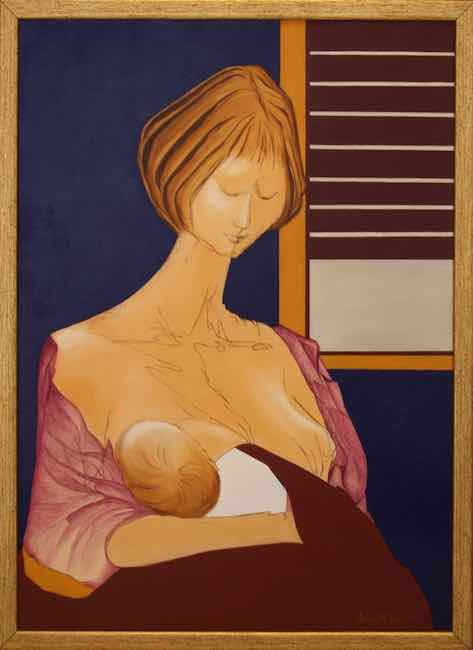
L’artista bolzanina Annamaria Vidotto, dopo aver studiato e approfondito a lungo diverse tecniche pittoriche, si orienta verso un suo linguaggio particolare e ben definito a metà tra l’Espressionismo vicino a quello di Amedeo Modigliani, per la sua capacità di reinterpretare i volti e le sensazioni dei personaggi che decide di rendere protagonisti, e il Surrealismo, seppure in lei solo accennato, di René Magritte, per quel voler andare a fondo di una semplice immagine, per studiare cosa si nasconda oltre ciò che la figurazione racconta a un primo sguardo e per le modificazioni che talvolta emergono quando la razionalità lascia spazio all’improbabile, all’irragionevole, all’inaspettato.
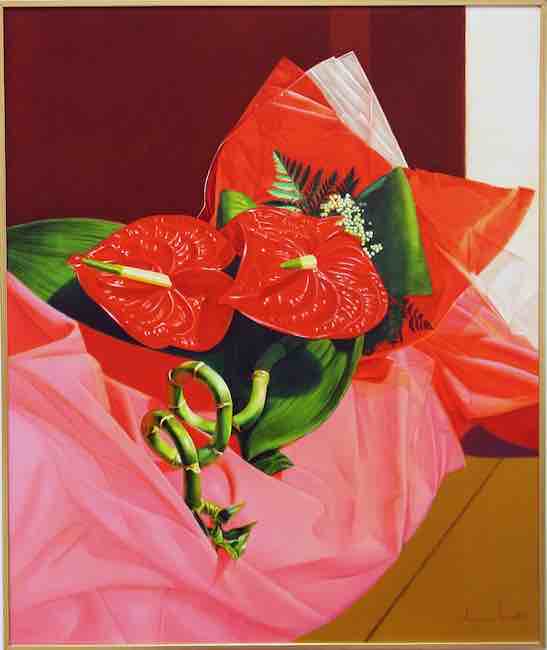
Artista fin da bambina la Vidotto coltiva la sua inclinazione creativa diplomandosi in Arti Figurative, successivamente prosegue gli studi presso l’Accademia di Belle Arti di Verona specializzandosi in diverse tecniche espressive. Questo lungo percorso di apprendimento le ha consentito di seguire strade coraggiose grazie alle quali potesse emergere il suo desiderio di indipendenza e di autonomia espressiva; ed è proprio in virtù della sua conoscenza dell’arte e delle varie tecniche che ha saputo dar vita a un suo personale Espressionismo in cui l’importanza del tratto del disegno potesse emergere chiaramente, senza essere inglobato nella pittura bensì restando protagonista, quasi come se la definizione e la stessa intenzione narrativa fosse sottolineata ed enfatizzata dalle sottili linee che appartengono indelebilmente al suo stile.
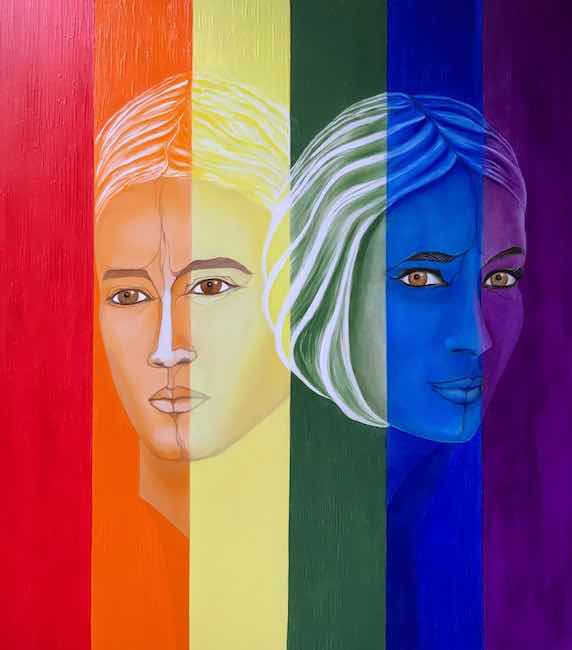
D’altro canto però Annamaria Vidotto non riesce a non infondere quel velato interrogativo, quelle domande che si pone chiunque venga a contatto con un altro essere umano, quei quesiti che emergono osservandone le espressioni, gli sguardi, addirittura la gestualità, rivelatori di tutto ciò che non viene detto né manifestato ma che resta parte celata all’interno dell’animo umano. È in questo che emerge il lato più surrealista dell’artista, quel suo decontestualizzare il soggetto per collocarlo all’interno della sua stessa struttura interiore, quella in cui l’esterno non esiste perché il vero dialogo è quello con se stesso.
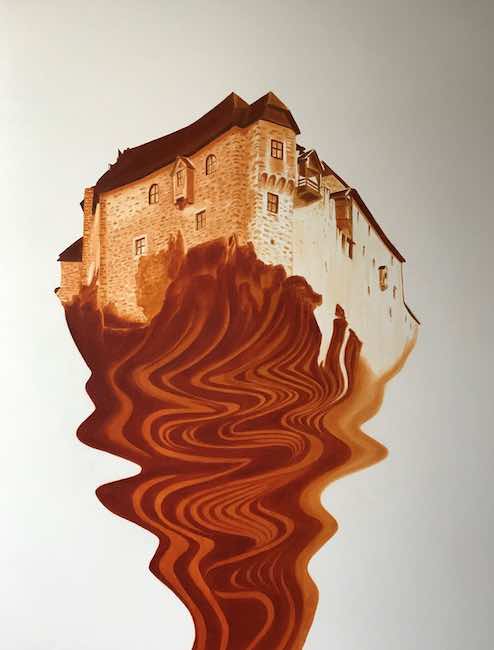
Nella tela Castello, completamente priva della presenza umana, la costruzione sembra essere sospesa nel cielo, come se fosse stata sradicata dalla realtà un po’ per portare l’osservatore verso un mondo da fiaba che per la maggior parte delle persone può essere a malapena immaginabile, un po’ perché nel mondo attuale appare anacronistico credere ancora nei principi e nelle principesse che l’edificio inevitabilmente evoca e dunque in qualche modo sembra voler portare lo spettatore a mettere i piedi per terra, a essere più realista perché è solo attraverso il duro lavoro che i sogni possono essere realizzati e niente arriva per caso o per regalo.
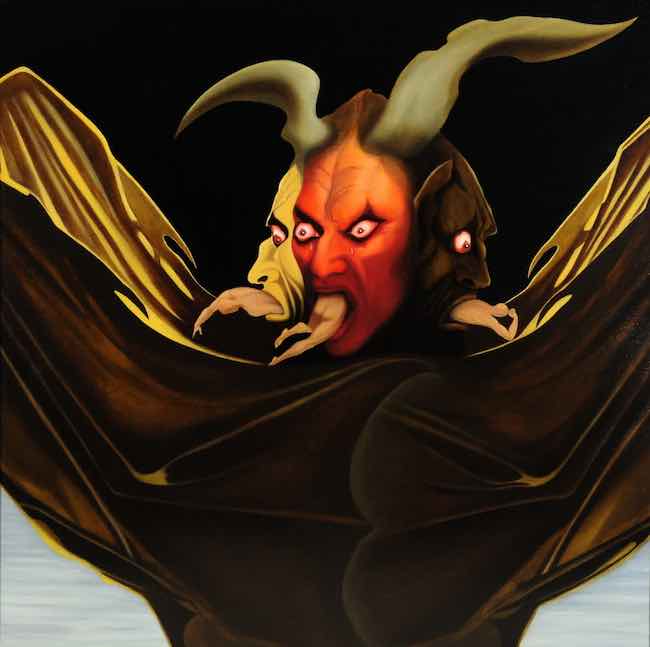
In Lui la Vidotto racconta del male, rappresentato da un Lucifero spaventoso e crudele il quale però diviene allegoria della capacità dell’essere umano di commettere errori e colpe generati dalle proprie cupidigie, dalla propria avidità, dall’arrivismo che talvolta lo induce a prevaricare l’altro senza per questo sentirsi in colpa; il lui citato nel titolo non è dunque il demonio bensì i tanti demoni che si nascondono dentro l’uomo e che si rivelano esattamente nel momento in cui la tentazione è più forte, quando sul piatto della bilancia c’è il prevalere o il soccombere, quando le insicurezze sono talmente incisive da indurre l’individuo a dimostrare a se stesso di valere di più di quanto egli stesso creda, e se per farlo deve scavalcare o ferire qualcuno, non importa, ciò che conta è un primato che alla fine può avere il solo risultato di farlo sentire solo. Questo forse è il senso delle lacrime della testa in primo piano, la voce della coscienza che prima o poi emerge e induce il protagonista a fare i conti con se stesso.
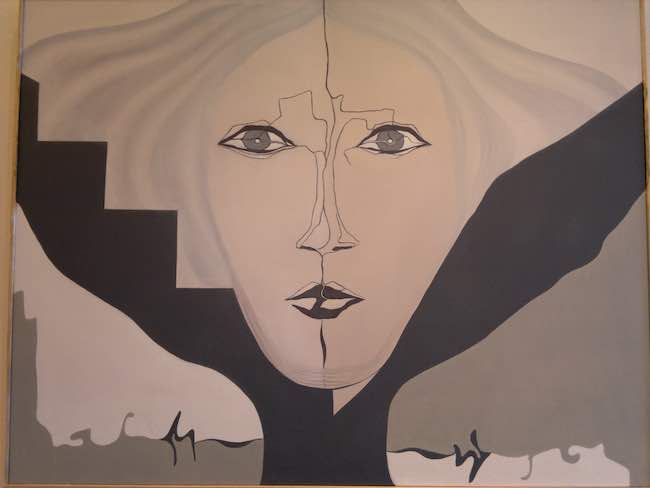
Nell’opera Imperfezioni simmetriche, in cui l’artista utilizza la scala di grigi, mette in primo piano un volto, decontestualizzato, su cui domina una geometricità irregolare, forse a sottolineare quanto l’asimmetria possa sopraggiungere a togliere quell’ordine predeterminato che tutto sommato renderebbe ogni cosa più monotona. Gioca con le consapevolezze e le certezze umane Annamaria Vidotto, suggerisce quanto possa essere essenziale non chiedere troppo a se stessi e accogliere gli eventi, le circostanze e la propria natura senza essere esigenti, prendendosi un po’ meno sul serio accettando le imperfezioni che sono in grado di rendere unico ciascun individuo. In questa opera è molto evidente il tratto grafico che contraddistingue l’artista e che si concentra sullo sguardo, sulla parte centrale del volto, come se i due emisferi dovessero combaciare solo per il breve tratto della consapevolezza ma poi potessero anche divergere se il caso lo richiede.
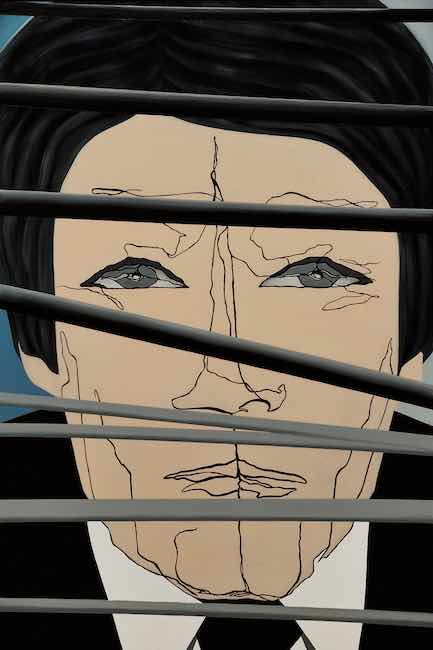
In Percezione invece il disegno sempre presente nelle sue opere diviene prioritario perché deve evidenziare quanto ciò che è osservato, o immaginato, appartenga all’interpretazione del singolo e rimanga tale almeno fino a quando non si intraprenda un percorso di indagine sulla realtà, attraverso cui sia possibile prendere reale consapevolezza degli accadimenti e solo a quel punto avere un quadro più completo. Annamaria Vidotto è iscritta all’Associazione degli Artisti della Provincia di Bolzano, all’Associazione Amici dell’Arte, alla Federazione Italiana Donne Arti Professioni Affari (F.I.D.A.P.A.) e al Club Arcimboldo; ha al suo attivo più di cinquanta mostre collettive e qualche personale ottenendo riconoscimenti molto positivi.
ANNAMARIA VIDOTTO-CONTATTI
Email: annam-v@hotmail.com
Facebook: https://www.facebook.com/annamaria.vidotto.56
Instagram: https://www.instagram.com/vidottoannamaria/
Annamaria Vidotto, Expressionism entering the folds of the surreal in her exploration of human nature
The contemporary artist often acts as a careful observer not only of the reality that surrounds existence but also of the various multifaceted personalities of those who cross his path, leading him to tend towards an interpretation of different subjectivities that go to make up the puzzle of what characterises modern life. Others, on the other hand, are in search of a deeper sense, pushing into the folds of irrationality to discover the hidden meanings that creep beyond the visible. And then there are those who mix the two different approaches to create their own personal stylistic signature that identifies and characterises them. The artist I am going to tell you about today belongs to the latter category of creatives.
At the moment when was created that rift between academic rules of expression and the need to give free rein to an interiority too often delimited by the executive schemes of traditional art, there emerged a desire to find a way to let flow, or rather to let prevail, the sensations and emotions that had never been part of an artwork, except in a few rare cases, and it was therefore necessary to find a new style of painting and sculpture that would allow the creatives to put all previous canons in the background. This was the moment when in France were born the Fauves guidelines, which found their natural evolution in Expressionism, a broad movement that spread throughout Europe, taking on different characteristics depending on the country of origin of the artists who adhered to it. In particular, on the one hand the Austrian Egon Schiele, with his need to maintain a strong contact with human reality with all its weaknesses and obsessions, and on the other hand the Italian Amedeo Modigliani, with his admiration for the feminine world made iconic and at the same time algid in its representation by virtue of the inspiration from Primitivism that influenced his artistic production, were the two expressionists who most of all maintained the link with observed reality, at least in the chromatic range and the evident but much more subtle presence of drawing.
At the same time, Expressionism was contemporary of another artistic movement that, rather than exploring the emotions, set out to study the psyche, the unconscious, the human mind when it was not dominated by rationality, when the subtle energies that revolve around the human being were listened to; the movement took the name Surrealism and, in addition to the more extreme and excessive representatives such as Salvador Dali, it also welcomed some more moderate masters, more interested in reflection and meditation around man rather than his perversions or his deepest anxieties. The Belgian René Magritte and the Frenchman Yves Tanguy described parallel worlds in which the greatest enigma was man and his position in the surrounding reality, where everything that appeared was different from what it really was, and where extreme imagination contributed to generating a different reality in which doubts and uncertainties were reflected in the way the world was observed. The Bolzano-born artist Annamaria Vidotto, after having studied and explored various painting techniques for a long time, moved towards her own particular and well-defined language somewhere between Expressionism close to that of Amedeo Modigliani, for her ability to reinterpret the faces and feelings of the characters she decided to make protagonists, and the Surrealism, albeit only hinted at in her, of René Magritte, for that desire to get to the bottom of a simple image, to study what is hidden beyond what figuration tells at first glance and for the changes that sometimes emerge when rationality gives way to the improbable, the unreasonable, the unexpected.
An artist since childhood, Vidotto cultivated her creative inclination by graduating in Figurative Arts, subsequently she continued her studies at the Academy of Fine Arts in Verona specializing in various expressive techniques. This long learning path allowed her to follow courageous steps through which her desire for independence and expressive autonomy could emerge; and it is precisely by virtue of her knowledge of art and the various techniques that she was able to create her own personal Expressionism in which the importance of the drawing stroke could clearly emerge, without being incorporated into the painting but rather remaining the protagonist, almost as if the definition and narrative intention itself were underlined and emphasised by the subtle lines that indelibly belong to her style. On the other hand, however, Annamaria Vidotto cannot fail to instil that veiled wondering, those questions that anyone who comes into contact with another human being asks themselves, those queries that emerge by observing their expressions, their looks, even their gestures, revealing everything that is neither said nor manifested but remains a hidden part within the human soul. It is in this that the artist’s more surrealist side emerges, her decontextualisation of the subject in order to place it within his own inner structure, one in which the outside does not exist because the real dialogue is with himself. In the canvas Castel, completely devoid of human presence, the construction seems to be suspended in the sky, as if it had been uprooted from reality partly to take the observer to a fairy-tale world that for most people can barely be imagined, partly because in today’s world it seems anachronistic to still believe in the princes and princesses that the building inevitably evokes, and therefore somehow seems to want to lead the viewer to put his feet on the ground, to be more realistic because it is only through hard work that dreams can be realised and nothing comes by chance or gift.
In He, Vidotto speaks of evil, represented by a frightening and cruel Lucifer who, however, becomes an allegory of the human being’s ability to commit errors and faults generated by his own greed, by his own avidity, by his own careerism, which sometimes leads him to prevaricate against others without feeling guilty about it; the he referred to in the title is therefore not the devil but the many demons that lurk within man and that reveal themselves precisely at the moment when temptation is strongest, when on the scales there is prevailing or succumbing, when the insecurities are so incisive that they lead the individual to prove to himself that he is worth more than he believes, and if in order to do so he has to step over or hurt someone, it does not matter, what matters is a supremacy that in the end can only result in making him feel lonely. This is perhaps the meaning of the tears of the head in the foreground, the voice of conscience that sooner or later emerges and induces the protagonist to come to terms with himself. In the artwork Symmetrical Imperfections, in which the artist uses greyscale, she places a face in the foreground, decontextualised, on which an irregular geometricity dominates, perhaps underlining how asymmetry can come to take away that predetermined order that would make everything more monotonous. Playing with human awareness and certainties, Annamaria Vidotto suggests how essential it can be not to ask too much of oneself and to accept events, circumstances and one’s own nature without being demanding, taking oneself a little less seriously by accepting the imperfections that are able to make each individual unique. In this painting, the artist’s distinguishing graphic line is very evident and focuses on the gaze, on the central part of the face, as if the two hemispheres should only match for the brief stretch of awareness but then could also diverge if the case required. In Perception, on the other hand, the drawing that is always present in her works becomes a priority because it must highlight how much what is observed, or imagined, belongs to the interpretation of the individual and remains so at least until a path of investigation of reality is undertaken, through which it is possible to become truly aware of the events and only then have a more complete picture. Annamaria Vidotto is a member of the Association of Artists of the Province of Bolzano, the Association of Friends of Art, the Italian Federation of Women in the Arts Professions and Business (F.I.D.A.P.A.) and the Club Arcimboldo; she has more than fifty group exhibitions and a few solo exhibitions to her credit, and has received very positive recognition.


